Episode 189
What you’ll learn in this episode:
- How Melinda created the definitive guide to the Napier Company.
- What made Napier stand out from other costume jewelry manufacturers of the 20th century.
- Why Chinese and Russian collectors are becoming increasingly interested in American costume jewelry.
- How the dawn of costume jewelry changed the way we accessorize.
- Why the craftsmanship of vintage costume jewelry is often as good as fine jewelry.
- Why being part of a community can be the most rewarding part of collecting.
About Melinda Lewis
Jewelry historian Melinda Lewis spent 11 years researching the history of a single American jewelry manufacturer —The Napier Co. Determined to bring the first book about this company to the public, she interviewed over fifty former employees from around the country spanning multiple generations. Those interviewed included the great-grandson of William Rettenmeyer, the designer who started in 1891; to designers who worked for Napier from 1941 to the close of the plant; as well as executive management, including the former CEO, Ron Meoni; and traveling salesmen, whose careers were no less than 30-plus years with the company.
After publishing her book, Lewis and her husband have spent the last year curating an extraordinary collection of vintage jewelry from around the country for her customers with The Jewelry Stylist and Vintage Jewelry Collect.
Additional Resources:
FACEBOOK: https://www.facebook.com/thenapierbook/
THE NAPIER BOOK: https://napierbook.com
FACEBOOK: https://www.facebook.com/thejewelrystylist2
INSTAGRAM: https://www.instagram.com/thejewelrystylist/
THE JEWELRY STYLIST: https://thejewelrystylist.com
VINTAGE JEWELRY COLLECT: https://vintagejewelrycollect.com
CJCI : http://cjci.co This forwards to https://www.costumejewelrycollectors.com/
Photos:
NAPIER 1920S CUFF
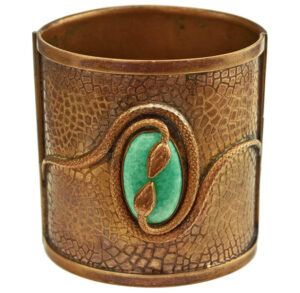
NAPIER 1950s CLUSTERED STONES NECKLACE
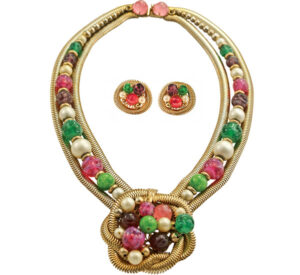
NAPIER 1950s FROSTED LEAVES PENDANT
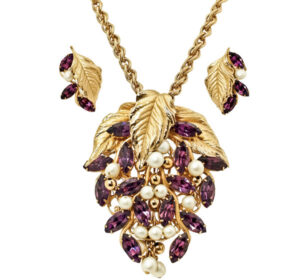
NAPIER 1950s ROCOCO DIE-STEMPED NECKLACE
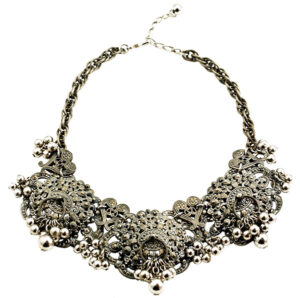
NAPIER 1950s TROPICANA BRACELET
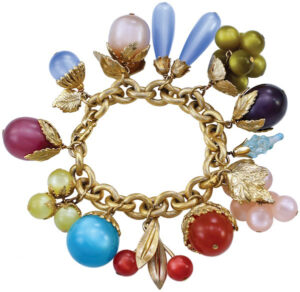
NAPIER 1992-GALLERIA COLLAR NECKLACE
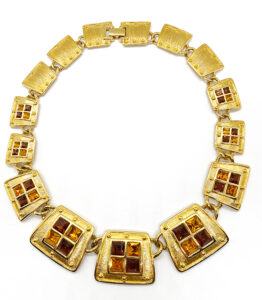
Napier book
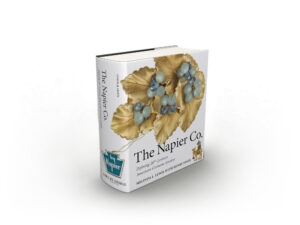
Transcript:
Some collectors don’t give costume jewelry a fair shake, but for jewelry historian Melinda Lewis, vintage costume jewelry has only brought her happiness. She spent over a decade researching The Napier Company, an influential costume jewelry manufacturer, and created a community of fellow costume lovers along the way. She joined the Jewelry Journey Podcast to talk about the process of researching and writing her book, “The Napier Co.: Defining 20th Century American Costume Jewelry”; what costume jewelry is trending and where the hot markets are; and why the joy of jewelry often lies in connecting with others. Read the episode transcript here.
Sharon: Hello, everyone. Welcome to the Jewelry Journey Podcast. This is the first part of a two-part episode. Please make sure you subscribe so you can hear part two as soon as it’s released later this week.
Today, we are talking with Melinda Lewis, the author of the definitive work on Napier Company jewelry, “The Napier Co.: Defining 20th Century American Costume Jewelry.” She’s also one of the founders of Costume Jewelry Collectors International. If you look at their website, CJCI.co, you’ll be able to find all you want to know about costume jewelry. Melinda is passionate about costume jewelry, which we might consider a pejorative term, but once you take a look at this book and the range of jewelry that was produced and the manufacturing techniques that were pioneered, you’ll never think about costume jewelry in quite the same way. We’ll hear about her jewelry journey today. Melinda, welcome to the program.
Melinda: Thank you for having me, Sharon. It’s my pleasure.
Sharon: So glad to have you. Tell us about your jewelry journey. How did you get into this?
Melinda: I was interested in costume jewelry as a teen by playing with and holding my grandmother’s costume jewelry, but it wasn’t until my late 30s, early 40s, that I really became interested. I went to an estate sale and bought a couple of sets, one being Hobé. I went home to begin my research and became completely fascinated by it. I stumbled upon an email list called Jewelcollect, which was owned by Liz Bryman, and from there, I went to my first jewelry conference held by Christine Romero at the Center for Jewelry Studies. I became completely intrigued with costume jewelry.
Sharon: Did you know you were buying a Hobé, or did you just like the way it looked?
Melinda: I loved the way it looked. It was marked, but I didn’t know what Hobé meant. It meant nothing to me because I had never really owned a piece of jewelry before. It opened up a whole new world for me.
Sharon: Had you liked any other kind of jewelry? Had you been a collector before this?
Melinda: No, not at all. I was working in hospital pharmacies, so it was a complete change. I appreciated fashion because my grandmother was a hat designer during the 20s, and I think a little bit of that rubbed off on me. I wanted to be a fashion merchandiser before I got into hospital pharmacy, but I never had any interest or knowledge about costume jewelry prior to going to that estate sale.
Sharon: Wow! Did you start collecting once you became more knowledgeable?
Melinda: I did start collecting and going to more estate sales. I was able to purchase the inventory from a business that was going out of business. My first big purchase literally filled my Volvo station wagon, front to back, with costume jewelry. From there, I opened up a shop. I had a physical shop for a year and went online after that.
Sharon: Was this jewelry that filled up your Volvo all different kinds?
Melinda: Yes, it was all different kinds. It was great fun.
Sharon: Why did you think it was necessary to write a book? Melinda has corrected my pronunciation. How do you say it?
Melinda: Napier.
Sharon: Napier, O.K. Do you think most people know that?
Melinda: Probably 50/50. I always tend to correct people. I think when people say it “Napié,” it maybe has more prestige to it, but Mr. Napier was Scottish, and in the Scottish pronunciation it’s Napier.
Sharon: Did you ever meet him?
Melinda: No, he died in 1960. But through my studies and after interviewing 53 former Napier employees, I was very clear about his preferences. He was a very strict man.
Sharon: I’ve been saying it wrong. I remember the ads I used to see in Seventeen Magazine a long time ago. I always read it as “Napié,” but I never had a reason to say it out loud.
How did you decide to write this book? I have to say to anybody who hasn’t seen the book, this is the definitive work. It’s beautiful and it’s big.
Melinda: It is big. In 2002, I had the opportunity to purchase part of the Napier archive. When it arrived at my home, I had all this jewelry and knew nothing about it. So, I went on the internet and saw the same paragraph being repeated over and over on all of the websites. I knew there was a void that needed to be filled, so I began my journey of doing research on the company.
I started with one name. Mr. Ron Meoni was the President of Napier before it was sold. I wrote a letter to him explaining that I wanted to write a book on Napier and asked if he would give any guidance or assistance. From there, he gave me six names. I reached out to all of those folks, including my coauthor, Henry Swen, who has since passed away. Henry worked for the company for 35 years. During my research, Henry and I literally corresponded every day for eight years back and forth. He really gave me the inside knowledge of how the industry worked and the history about Napier. It was a phenomenal experience. I’m forever grateful to him for his assistance.
Sharon: So, you’re ready to write your next book on a different company.
Melinda: I don’t know. I still research Napier all the time. There’s still more information, but I put them up on our Facebook page.
Sharon: There are so many illustrations and drawings. It’s hard to believe there are more.
Melinda: Oh, there are a lot more. I just put a fraction of it in. Finally, I had to say stop, because I could have kept going when the book was already way larger than what I had anticipated.
Sharon: How long did it take you to write this?
Melinda: It was 11 years of writing and research, 12 years altogether with the layout. So, the project was 12 years long, but 11 years of that I spent researching and writing.
Sharon: When you say it’s different than what you thought it would be starting out, did you think it would be a paperback or a pamphlet? What did you think?
Melinda: Normally books in this genre are about 288 pages, so that was our goal. But what I realized as I was writing was that there was so much I wanted to include that hadn’t been included in other costume jewelry books: the marketing, the manufacturing, the designers, so many aspects that were different than just having a picture book. The more we got into that, the bigger the book became. I have about 60 pages just on marks and bindings and that type of thing alone to help guide the collector to circulate their jewelry.
In the beginning, I thought it would be a normal price book with a little bit of history interjected here and there. I felt if I did that, I was doing the company a disservice because I wouldn’t be representing it as fully as I felt it needed to be represented. It really became an encyclopedia; it’s so huge.
Sharon: It’s a beautiful book. Besides the pictures of the jewelry, there are things about the business you’ve never seen. That was interesting; the marketing, the design, the manufacturing.
Melinda: Yes, I think because we covered those areas, it can give the collector a greater appreciation of what went into the manufacturing of the lines. I’m quite proud of that.
Sharon: Did you have any resistance in terms of people who wouldn’t provide information or photographs? Would they say it’s a company secret?
Melinda: The one thing I felt and experienced was that everyone was very protective of Mr. Napier, extremely protective. He had been gone for over 40 years, but his privacy and their unwillingness to share things sometimes because they didn’t want to paint him in a negative light was quite interesting. So, yes, some employees were very protective of Mr. Napier. They respected him highly.
There are certainly stories I learned about him that will never be published, but his reputation was protected by his employees. They never really said anything negative about him. He was a very strict manager, so to speak. He held his employees to the highest standard, and if you didn’t comply with that, you were out with no ifs, ands or buts. Napier means “without equal,” and he stood by that as a company mantra. He expected nothing but the best.
Sharon: What language is that in? I didn’t think it meant anything.
Melinda: I’m not sure. I thought it was Scottish. The employees talked about that, about Napier meaning without equal. I haven’t studied the etymology of that particular word, so I can’t say for certain.
Sharon: Tell us about the book. You have so many beautiful images and pictures and photographs. Tell us how many pictures and how you got them.
Melinda: The book is 1,012 pages long. There are over 4,000 images and 250,000 words. A lot of the pictures came from employees themselves, especially the early renderings for E.A. Bliss and pictures in the 1920s. A lot of it came from Napier employees supplying me with the information. Unfortunately, I did not have access to the Napier paper archives, so basically everything in the book was given to me by Napier employees, in terms of ads and that type of thing.
99% of the pictures are images I took of the actual jewelry. While I traveled across the country, I would photograph the collections, and then we had them edited for the book.
Sharon: Did employees tell you, “This person has a collection in Wyoming,” or “This person is in Kentucky”? How did you find it?
Melinda: I found it through the collections of the employees I interviewed. I didn’t interview anyone that was outside the company. Some people did supply their images. When I noticed something on eBay, I would write them and say, “I’m writing a book on Napier. Would you be interested in allowing me to include your image in the book?” So, some of them are from people in the trades who were selling on eBay, but for the most part it was either Napier employees’ collections or pieces I had acquired from the archives.
Sharon: Do you think that Napier, because he pioneered a lot of the manufacturing techniques, do you think it’s true that it was without equal? Or were all the costume jewelry companies doing the same thing?
Melinda: The thing that made Napier stand out from the other companies was that it used multiple manufacturing techniques. It had die-stamped jewelry, things that involved wire bending or casting or what they called stranding. They did pioneer some new techniques, especially during the war time when they were under government contracts. So did other jewelry companies, but what made them unique was that they had the ability to manufacture jewelry in multiple ways so they could respond to the market quite easily.
Sharon: I always think of the big three of costume jewelry being Napier, Trifari—I talked to a Trifari expert who told me that’s wrong, but Trifari, and the third one is—
Melinda: Monet.
Sharon: Monet, that’s right.
Melinda: Yes.
Sharon: What made Napier different?
Melinda: Monet did what’s called metal. Trifari did color, more rhinestones. Marvella, which was another big one, did pearl. Napier did all three. It could go into a department store and fill the needs of a jewelry department with its entire line. That’s what made it quite competitive. They would go in, probably often before the other salesmen got to go meet with the jewelry buyer, and they would sell their entire lines. If that store needed metals, they could supply metals. If they needed pearl, Napier could provide them with pearl. If they needed color, Napier had that.
Now, Napier’s color or rhinestone jewelry sometimes had a distinct look because they utilized the dye-stamping technique. You’d get those really great, embossed, highly detailed metal pieces that were accented with rhinestones. But Napier also did rhinestone jewelry like Weiss—I mean the styles and techniques would be similar to Lee Serge or something like that. People are often surprised when they see the glitzy Napier rhinestone jewelry and don’t realize Napier did that too. Yes, they did. They were able to offer the jewelry buyer a broad spectrum of inventory. They were a small company playing in a big pond with big players.
Sharon: Were they mostly manufacturing back east?
Melinda: Yes, in Meriden, Connecticut. Later they had a satellite factory for their model making in Providence, Rhode Island, because that’s where most model makers lived. They did some of their manufacturing in Providence, but mainly it was in Meriden, Connecticut.
Sharon: Somebody who’s into costume jewelry—I can’t remember who—told me that one of them is still collectable and reasonably priced. It wasn’t Napier, but I think it was Trifari. They said if you saw a piece of Trifari, you should grab it. Would you agree with that?
Melinda: Trifari is very hot right now. So is Schreiner in part because of the Chinese and Russian markets. 90% of the higher-end Trifari or Schreiner is going out of our country right now to collectors in China and Russia. That’s a new phenomenon. Costume jewelry collecting tapered off a little or hit a lull, but these new markets have really changed things in the last year or so. The realized prices have been phenomenal.
In terms of Monet, there are still a lot of bargains to be found. There are some things that may cost a couple of hundred dollars or so. With Napier, the prices have remained steady over the last 10 years, but I’m now shipping to China. That’s a new phenomenon. I’m starting to sell a lot of the higher-end Napier to our Chinese customers.
Sharon: There are not that many department stores around anymore. I can think of two maybe, but when you see costume jewelry, do you go in and look at it? If you haven’t seen it before, do you look at the back? Do you look at the way stones are put in it? What do you look at, or do you look?
Melinda: I do. You look at all of the above. The back is just as important as the front in terms of looking at the construction. On occasion, when we go to the city, I’ll go look at the jewelry departments, but I haven’t really been looking at new contemporary jewelry because my focus has always been on jewelry that’s made prior to 2000. I don’t go shopping that much for the new lines.
Sharon: I guess I’m thinking of Oscar de la Renta, which has a costume jewelry line. They license it to whoever did it. Do you look at the back? Do you look at whether it was done 20, 30 years ago?
Melinda: Sure, you look at the back and the front. Oscar de la Renta has been made in the U.S. by Gem-Craft in Providence, and it’s really beautiful. A lot of the contemporary pieces for the Oscar de la Renta line are wonderfully made. It’s a great example of a contemporary line being made in the U.S.
Sharon: I’ll find myself saying, “Oh, it’s just costume.” Why do you think “costume” was pejorative? At first it wasn’t pejorative, but now it’s become, “Oh, it’s costume.” What happened?
Melinda: For me, I haven’t experienced that. Maybe that’s because of the people I surround myself with. Costume jewelry elicits feeling of happiness. I don’t think of it in a negative term, but perhaps some of our younger people who are minimalists do. If you were a minimalist, I could see why you wouldn’t want to deal with costume jewelry. That’s just frivolous. There are more important things to deal with. But in my community, costume jewelry is nothing but a positive. I don’t have that negative attachment to it.
Sharon: Maybe it’s just me. Why did they start making costume jewelry? What I’m always surprised by is that everything was just as nice about it, but it wasn’t a real ruby. That’s all. It was a synthetic one.
Sharon: We will have photos posted on the website. Please head to the JewelryJourney.com to check them out.

